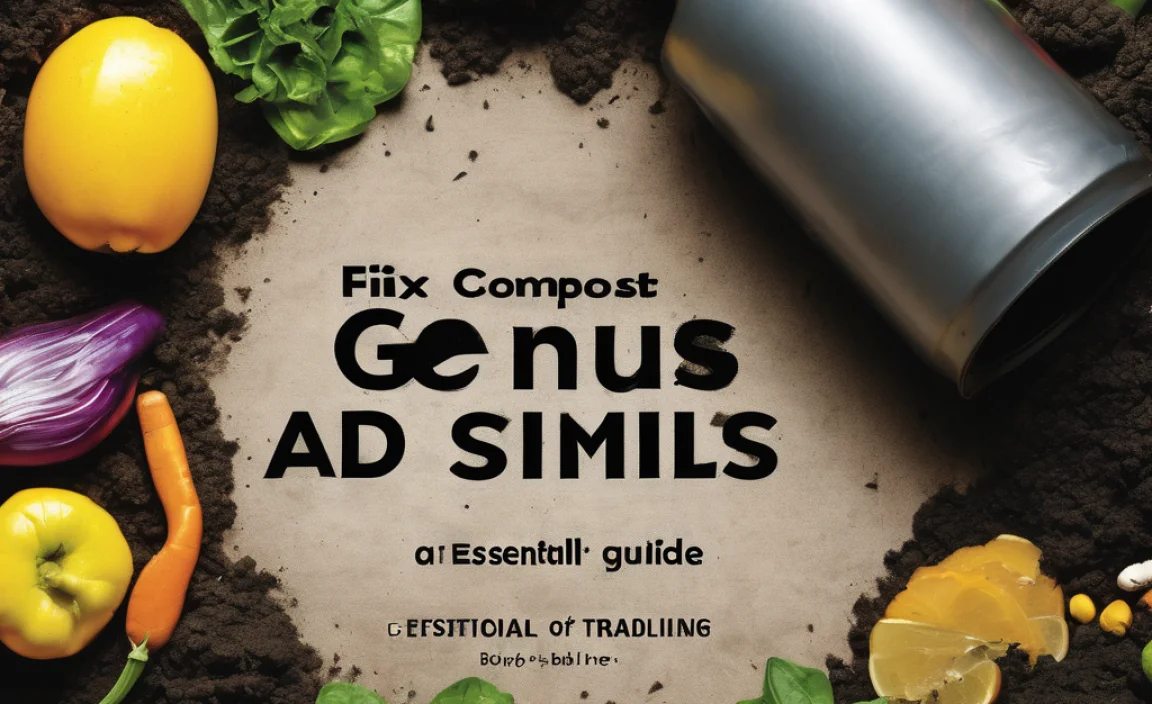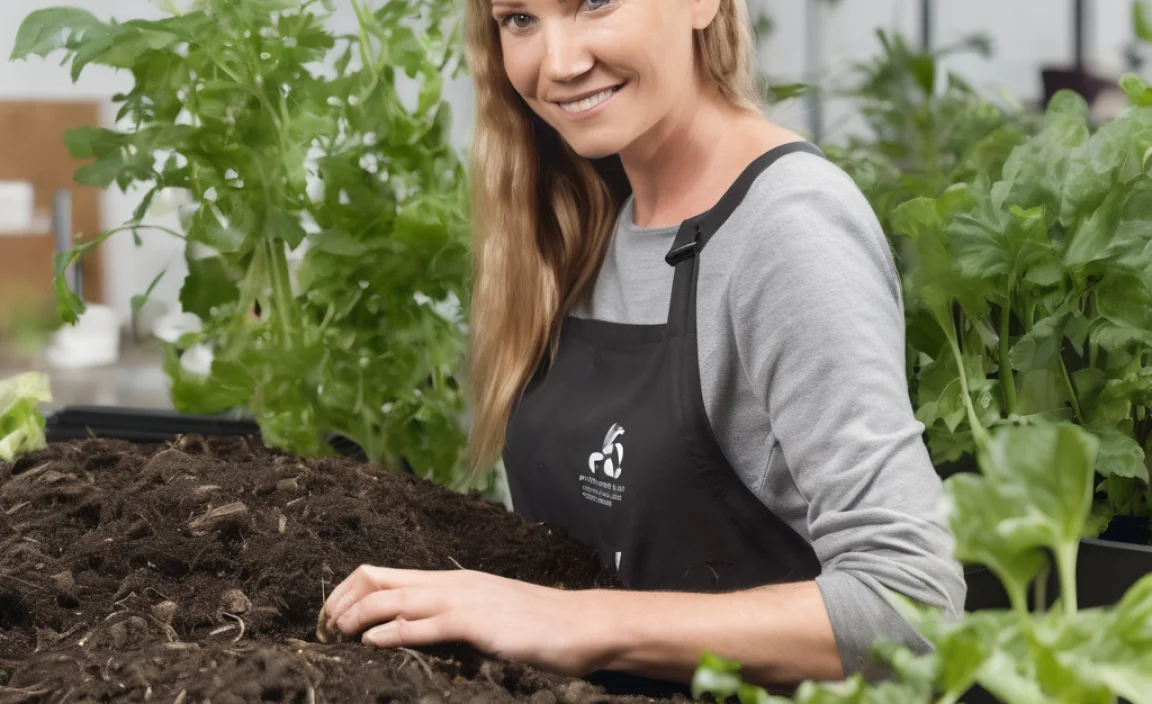Hey friends! Troy D Harn here from TopChooser. Are you looking to make your office a little greener? Maybe you’ve heard of composting but think it’s too complicated for a workplace? It’s a common worry! Many folks feel overwhelmed by the idea of starting something new at work. But guess what? Composting in an office can be super simple and incredibly rewarding. We’re going to break it down, step-by-step, so you can feel confident and get your office composting program rolling.
You might be thinking, “An office composting course? Isn’t that for farmers or serious gardeners?” Not at all! Think of this guide as your friendly neighbor showing you how to get started. We’ll cover everything you need to know, from setting up your bins to getting your colleagues excited. Ready to turn those coffee grounds and paper scraps into something amazing?
Why Your Office Needs a Composting Course (and Program!)
Let’s face it, offices generate a lot of waste. From paper towels and food scraps to uneaten lunches, a good chunk of what we throw away could actually be composted. Setting up a composting program isn’t just about being eco-friendly; it has real benefits for your company and your employees.
Reduces Landfill Waste
When organic materials go to a landfill, they decompose without oxygen. This process creates methane, a potent greenhouse gas. Composting, on the other hand, is aerobic (with oxygen) and significantly reduces methane production. Diverting compostable waste from landfills lowers your office’s environmental footprint.
Saves Money
Many waste management companies charge based on the volume or weight of your trash. By reducing the amount of waste you send to the landfill, you can sometimes negotiate lower waste disposal fees. Plus, creating nutrient-rich compost can be a great perk if your office has any green spaces or garden areas.
Boosts Employee Morale and Engagement
Initiatives like composting show that your company cares about sustainability and employee well-being. It’s a tangible way for everyone to contribute to a greener future. Getting employees involved can foster teamwork and a sense of shared purpose. It’s a feel-good activity that everyone can participate in.
Enhances Company Image
In today’s world, corporate social responsibility (CSR) is a big deal. A visible composting program can enhance your company’s reputation as an environmentally conscious organization. This can be attractive to clients, partners, and potential employees.
Getting Started: The Absolute Basics of Office Composting
Starting an office composting program doesn’t require a huge investment or a lot of space. The key is to keep it simple and make it easy for everyone to participate. Think of it as adding a few smart steps to your office’s daily routine.
Step 1: Form a Green Team or Champion
Find a few enthusiastic individuals who are passionate about sustainability. This ‘Green Team’ can spearhead the effort, communicate with management, and engage colleagues. Even one dedicated person, a ‘Composting Champion,’ can get the ball rolling!
Step 2: Assess Your Office Waste
Before you buy anything, take a look at what your office throws away most. Are you tossing a lot of paper towels, coffee grounds, and fruit peels? Knowing this helps you decide what kind of composting system will work best. You can do a quick waste audit by observing the trash bins for a few days.
Step 3: Choose Your Composting Method
There are a few popular options for offices, depending on your space, budget, and the volume of organic waste you produce.
Option A: On-Site Composting Bins
This involves setting up composting bins within the office or a designated outdoor area. It’s great for offices that want to manage their compost themselves and potentially use the finished product.
- Tumbler Composter: These are sealed bins that rotate, making it easy to mix materials and speed up decomposition. They are good for controlling odors and pests.
- Stationary Bins: Larger bins, often made of wood or plastic, that sit in one place. These usually require manual turning with a fork or aerator.
- Worm Composting (Vermicomposting): Uses special worms to break down food scraps. This is very efficient and can be done indoors in a relatively small space.
Option B: Off-Site Composting Services
This is often the easiest route for busy offices. You partner with a local commercial composting service. They provide bins, pick up your compostable waste regularly, and handle the composting process off-site.
- This is a great option if you have limited space or staff time.
- Research local composting services in your area. Many municipalities or private companies offer these solutions. For example, in the US, the Environmental Protection Agency (EPA) has resources on composting and waste reduction.
Step 4: Educate Your Colleagues
This is crucial! Everyone needs to know what can and cannot be composted. Keep the information simple and visual. You can use posters, email newsletters, or short training sessions. Make it clear and easy to follow. A simple visual guide is often the most effective.
Step 5: Set Up Collection Points
Place designated composting bins in convenient locations, like kitchens, break rooms, and near printer stations (for compostable paper waste, if applicable). Make sure these bins are clearly labeled with what goes in them.
Step 6: Manage and Maintain
If you’re composting on-site, you’ll need to manage the bins. This includes adding the right mix of ‘greens’ (wet, nitrogen-rich materials like food scraps) and ‘browns’ (dry, carbon-rich materials like paper and cardboard), turning the compost, and ensuring proper moisture levels. If you’re using a service, just make sure the bins are accessible for pickup.
What Can Be Composted in an Office?
Knowing what goes into the compost bin is key to a successful program. Generally, you want to stick to organic materials. Here’s a handy guide:
Compostable Items (The “Greens” and “Browns”)
- Food Scraps: Fruit and vegetable peels, coffee grounds and filters, tea bags (without staples or plastic), eggshells.
- Paper Products: Paper towels (unbleached preferred), napkins (plain, unlaminated), cardboard (torn into small pieces, no glossy finishes), paper cups (if certified compostable).
- Yard Waste (if applicable, e.g., from office plants): Small amounts of leaves or clean plant trimmings.
Items to Avoid
- Meat, Fish, and Dairy Products: These can attract pests and create foul odors.
- Oily or Greasy Foods: Can slow down decomposition and cause smells.
- Diseased Plants: Can spread pathogens.
- Fats, Grease, and Oils: Same reasons as meat and dairy.
- Plastics and Synthetics: Even if they seem biodegradable, they often don’t break down in typical composting conditions.
- Chemically Treated Paper: Like shiny or laminated paper, or paper with heavy ink.
- Styrofoam, Foil, Glass, Metal: These are non-organic contaminants.
It’s important to remind everyone to check packaging for “compostable” certifications. Not all “eco-friendly” packaging is actually suitable for composting.
Choosing the Right Composting Bin for Your Office
The type of bin you choose depends on your office’s size, how much waste you produce, and whether you have dedicated space for it. Let’s look at some practical options.
Types of Office Composting Bins
Small Kitchen Countertop/Under-Sink Bins
These are great for collecting food scraps before they are transferred to a larger bin or collected for off-site service. They are usually small, lidded containers that can help minimize odors.
Worm Composting Bins (Vermicomposting)
Ideal for offices with limited space, worm bins can be kept indoors. They are contained systems filled with composting worms that efficiently break down food scraps. A popular brand known for its durable and user-friendly worm farms is Uncle Jim’s Worm Farm.
Outdoor Tumbler Composter
If your office has outdoor space, a tumbler is a good option. They are sealed units that prevent pests and odors. You can easily mix the contents by rotating the drum. Look for durable, UV-resistant models. Many garden supply stores carry brands like Gardners which offer sturdy options.
Stationary Outdoor Bins
These are larger, often more durable bins for significant amounts of organic waste. They require manual turning, which might be more labor-intensive. They can be made from wood, plastic, or wire mesh.
Factors to Consider When Buying
- Capacity: How much organic waste does your office generate daily/weekly?
- Odor Control: Many office bins, especially indoor ones, prioritize odor containment.
- Pest Resistance: A sealed or enclosed bin is best for preventing unwanted visitors.
- Ease of Use: How easy is it to collect, add materials, and maintain?
- Space Availability: Do you have room indoors or outdoors?
- Budget: Prices can range from simple kitchen caddies to more expensive tumblers.
On-Site vs. Off-Site: Making the Right Choice
Deciding between managing your compost on-site or using a service is a big step. Each has its pros and cons, and the best choice depends on your office’s specific situation.
On-Site Composting
This means your office handles the collection, management, and processing of organic waste internally.
Pros:
- Potentially Lower Cost: Saves on service fees in the long run.
- Control: You manage the process and quality of compost.
- Educational Value: Great for engaging employees with the composting process itself.
- Finished Compost: If you have office plants or a common area garden, you can use the finished compost.
Cons:
- Labor Intensive: Requires time and effort from staff for collection, turning, and maintenance.
- Space Requirements: Needs suitable space for bins, especially outdoors for larger systems.
- Odor/Pest Potential: If not managed perfectly, can lead to smells or pests.
- Requires Knowledge: Staff need to understand the composting science to ensure success.
Off-Site Composting Service
You partner with a professional company that collects your organic waste.
Pros:
- Low Effort: Extremely convenient for staff; just fill the bins.
- No Space Worries: No need for large composting equipment on-site.
- Odor and Pest Control: The service handles all aspects of processing.
- Expertise: Professionals ensure correct composting methods are used.
Cons:
- Ongoing Cost: Regular service fees can add up.
- Less Control: You don’t directly manage the composting process.
- Dependent on Availability: Service may not be available in all areas or may have specific pickup schedules.
Quick Table Comparison
| Feature | On-Site Composting | Off-Site Composting Service |
|---|---|---|
| Convenience | Low (requires staff effort) | High (minimal staff effort) |
| Cost | Lower long-term, higher upfront for equipment | Higher ongoing (service fees) |
| Space Needs | Moderate to high (for bins and processing) | Low (only for collection bins) |
| Odor/Pest Risk | Moderate (if not managed well) | Very Low (managed by professionals) |
| Staff Engagement | High (direct involvement) | Low (participate by collection) |
For most offices just starting out, or those with limited resources, an off-site composting service is often the most practical and successful approach. It removes the complexity and potential issues, allowing everyone to participate easily.
Engaging Your Coworkers: Making it a Team Effort
A composting program only works if people participate. Getting your colleagues on board is key. Here’s how to make it a success:
1. Make it Visible and Accessible
Place clearly labeled composting bins in high-traffic areas like kitchens, break rooms, and near water coolers. Use simple, universally understood symbols alongside text.
2. Communicate Clearly and Consistently
Send out regular updates via email or an office Slack channel. Share success metrics (e.g., “We diverted X pounds of waste this month!”). Use internal newsletters or bulletin boards.
3. Lead by Example
When management and team leaders actively participate and advocate for the program, others are more likely to follow.
4. Make it Fun!
- Organize a “Compost Champion” award for departments or individuals who excel at participating.
- Hold a small launch event with treats and an explanation of the program.
- Share fun facts about composting or the positive impact it’s having.
5. Provide Simple Training
Host a brief “lunch and learn” session to explain the basics. Show people what goes where. A short, engaging video can also be very effective.
6. Get Feedback
Ask employees for their thoughts on the bins, signage, or process. Are there any challenges they’re facing? Their input can help improve the program.
Troubleshooting Common Office Composting Issues
Even with the best intentions, you might run into a few snags. Don’t worry! These are usually easy to fix.
Issue: Bad Odors
Cause: Often caused by too much “green” (food scraps) and not enough “brown” (carbon materials), or by meat/dairy products. Lack of airflow can also be a culprit.
Solution:
- If on-site composting, ensure a good balance of greens and browns. Add more shredded cardboard or paper.
- Turn the compost pile more frequently to introduce oxygen.
- Make sure food scraps are fully covered by brown materials.
- If using a service, ensure you are not putting in prohibited items like meat or dairy.
Issue: Pests (Fruit Flies, Rodents)
Cause: Exposed food scraps, especially in warmer weather.
Solution:
- Use bins with tight-fitting lids.
- Bury fresh food scraps under a layer of “browns” (like shredded paper or coffee grounds).
- If on-site, ensure outdoor bins are securely closed and not attracting pests due to improper management.
- With off-site services, smaller collection bins with lids are usually sufficient.
Issue: Low Participation
Cause: Lack of awareness, confusion about what to compost, or inconvenience.
Solution:
- Revisit the education campaign: More clear signage, reminders, and maybe a quick training session.
- Make bins more visible and accessible.
- Highlight the benefits and successes of the program.
- Get managers to champion the effort.
Issue: Contamination (Wrong Items in Bin)
Cause: People are unsure or don’t check labels properly.
Solution:
- Improve signage: Add pictures, use clear language.
- Regularly communicate what is and isn’t compostable.
- If using an off-site service, they often have systems to filter out contaminants, but minimizing them at the source is best.
Remember, a few minor hiccups are normal at the start. The key is persistence and continuous communication. For more detailed guidance on compost science, you can often find helpful information from university extension offices, like those managed by Utah State University Extension.
Quick Summary: Your Office Composting Checklist
Here’s a quick rundown to keep handy:
- Form a Team: Get a Green Team or Champion onboard.
- Assess Waste: Understand what you’re throwing away.
- Choose Method: On-site or Off-site service?
- Select Bins: Proper size with good odor/pest control.
- Educate Staff: Clear, simple guides on what to compost.
- Set Locations: Conveniently placed, well-marked bins.
- Promote & Engage: Make it a team effort!
- Monitor & Adjust: Troubleshoot issues as they arise.
Conclusion: Greening Your Workspace, One Scrap at a Time
Starting a composting program in your office might seem like a big undertaking, but with the right approach and this essential guide, it’s totally achievable. By choosing the right method, educating your team, and making participation easy, your office can significantly reduce its waste output and contribute to a healthier planet.
Whether you opt for a convenient off-site service or manage an on-site system, every bit of compostable material you divert makes a difference. It’s a fantastic way to foster a greener culture within your workplace and show that your company is committed to sustainability. So, gather your green team, pick a starting point, and get ready to turn waste into a valuable resource. Happy composting!
Frequently Asked Questions (FAQ)
What is the primary goal of office composting?
The main goal is to divert organic waste, like food scraps and paper products, from landfills. This reduces greenhouse gas emissions and creates nutrient-rich compost.
How can we prevent odors from office compost bins?
Ensure a good balance of “greens” and “browns,” bury food scraps under brown materials, use bins with tight-fitting lids, and ensure proper ventilation if using on-site systems. If using an off-site service, follow their guidelines for what to include.
Can we compost office paper products?
Yes, plain, unbleached paper towels, napkins, and cardboard (torn into small pieces) are generally compostable. Avoid glossy, laminated, or heavily inked papers.
What if our office doesn’t have outdoor space?
If outdoor space is limited, consider a worm composting bin (vermicomposting) indoors, or opt for an off-site composting service that provides bins for your kitchen or break room and collects them regularly.
How do we get management buy-in for a composting program?
Highlight the benefits: cost savings on waste disposal, enhanced company image, employee morale boost, and meeting sustainability goals. Present a clear, simple plan focusing on ease of implementation, especially if choosing an off-site service.
How often should office compost bins be emptied or serviced?
For countertop bins, daily or every few days. For larger bins or off-site services, this depends on your waste volume and the service provider’s schedule, typically ranging from weekly to bi-weekly pickups.

I am passionate about home engineering. I specialize in designing, installing, and maintaining heating, ventilation, and air conditioning systems. My goal is to help people stay comfortable in their homes all year long.



